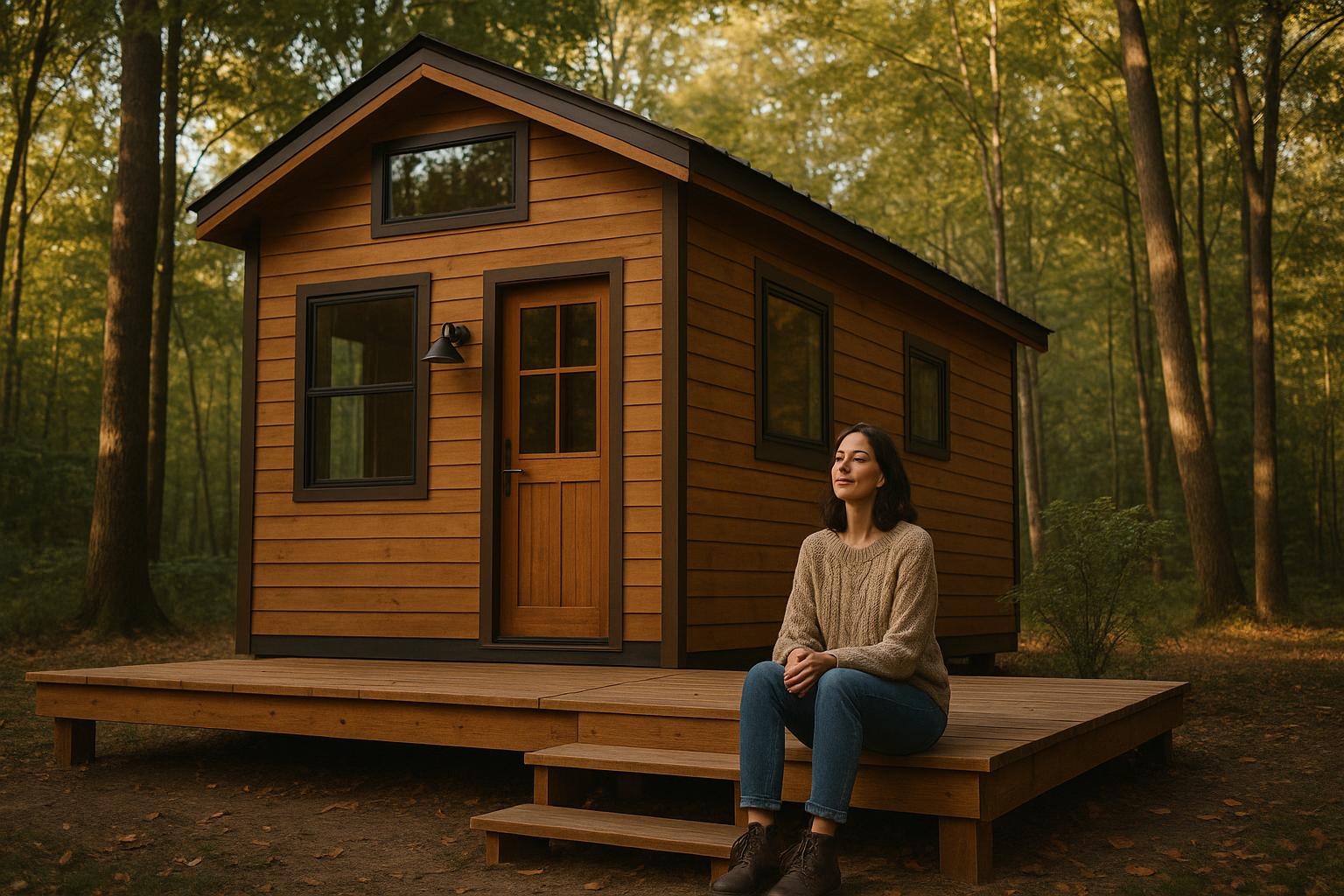
The Impact of Tiny Homes on Mental Health and Wellbeing in Canadian Living
Estimated reading time: 8 minutes
Key Takeaways
- Tiny home living can support mental health by promoting mindfulness and reducing daily stress.
- Thoughtful design—with an emphasis on natural light, air quality, and proper insulation—is critical for wellbeing.
- Community connections in tiny home settings help combat isolation and build emotional support.
- Challenges such as limited space, privacy issues, and harsh climate adaptation must be managed carefully.
Table of contents
Mental health is a crucial part of our overall wellness. In Canada, it influences how we think, feel, and interact with the world. At the same time, more Canadians are exploring tiny homes—small, carefully designed spaces—as a practical and affordable living choice. But how does living small affect mental health, wellbeing, and stress reduction? In this post, we’ll look closely at the psychological benefits and challenges of tiny homes in Canadian living, and share evidence-backed tips to boost wellbeing in even the smallest of spaces.
Understanding Mental Health and Wellbeing in the Context of Living Spaces
What Is Mental Health and Wellbeing?
Mental health means your emotional, psychological, and social balance. It’s about how you handle stress, relate to others, and make choices. Wellbeing is broader: it covers happiness, life satisfaction, and finding purpose in daily living.
Quick Facts:
- Mental health is shaped by our feelings, our problem-solving approaches, and our social connections.
- Wellbeing is reflected in overall happiness, life satisfaction, and a sense of purpose.
- Your living situation—where and how you live—plays a significant role in your psychological health.
The Link Between Physical Spaces and Mental Health
Where we live can shape our state of mind. Good design, spacious environments, abundant sunlight, and comfort make us feel secure and relaxed. In contrast, cramped, dark, or unstable homes can increase stress and spark anxiety.
In Canada, Consider:
- High urban density may lead to heightened stress and isolation.
- Harsh winters force many indoors, making the quality of the home environment even more important.
- The pursuit of affordable, secure housing is inseparable from the search to ward off loneliness.
Notably, research shows that in Canada, people living in insecure or poor-quality housing have higher risks for mental health challenges [source].
Tiny Homes: Design Principles for Wellbeing
Tiny homes in Canada typically range from 80 to 700 square feet. Smart design in these homes focuses on:
- Maximizing natural light to elevate mood.
- Ensuring high air quality.
- Creating a sense of belonging through thoughtful community design.
It’s not just the size of your home that counts, but how effectively the space is used in your daily life [source]. For innovative design ideas on tiny home interiors, see this resource.
Psychological Benefits of Living in Tiny Homes
Stress Reduction Through Minimalist Living
Downsizing to a tiny home often inspires a minimalist lifestyle. Owning fewer possessions can lead to a reduction in daily stressors from chores, clutter, and decision-making. Many enthusiasts report feeling less anxious and more at peace in a simplified living space [source]. For detailed techniques on minimalist living, check this guide.
How Tiny Homes Support Mental Health and Wellbeing:
- Sense of Control Over Your Environment: Managing every corner of your home boosts autonomy, a key element for mental health [source].
- Enhanced Mindfulness: Smaller spaces encourage you to reflect on your belongings and your lifestyle choices, leading to more mindful routines [source].
- Intentional, Organized Spaces: The necessity for thoughtful space utilization leads to tidier environments that help reduce stress. For smart storage solutions, visit this resource.
- Community Connection: Many Canadian tiny home communities are designed to foster social interaction. Neighbours support each other through community events, reducing feelings of isolation [source]. Learn more about community benefits at this link.
Additional Benefits:
- Lower utility and maintenance costs reduce financial stress.
- A lifestyle of intentional living often boosts self-esteem and happiness.
- Supportive community clusters provide emotional safety and shared resources.
Research Insight: Embracing minimalist living in a tiny home has been shown to reduce anxiety and increase life satisfaction for many Canadians [source].
For more insights, see also this article and this resource.
Challenges to Mental Health When Living in Tiny Homes
Stressors Unique to Tiny Home Life
While tiny homes offer notable benefits, they also come with challenges. Certain aspects of tiny living may increase stress if not addressed properly, especially within the Canadian context.
Major Challenges:
- Limited Space and Crowding: Small quarters can feel confining for families or roommates. A lack of private spaces may lead to constant interruptions [source]. For privacy solutions and smart zoning in small spaces, see this guide.
- Privacy Concerns: The overlap of living, sleeping, and working areas can strain relationships and reduce opportunities for quiet reflection.
- Risk of Social Isolation: Remote locations or a lack of community support can lead to feelings of loneliness, particularly during long Canadian winters.
- Canadian Climate Demands: Severe winters require excellent insulation and heating. Poorly insulated tiny homes can become uncomfortable and negatively affect mental health [source]. For guidance on winter-proofing, review this resource.
- Design Flaws or Poor Community Planning: Without attention to light, air, storage, and soundproofing, a tiny home might increase stress rather than alleviate it.
Special Considerations:
- Homes accommodating multiple residents require clear zoning and privacy guidelines.
- Weather-related isolation is more pronounced in rural areas, necessitating thoughtful community planning.
Research Shows: Poor design and insufficient community support in tiny home environments can exacerbate mental health challenges [source].
Stress Reduction Tips Tailored to Tiny Home Living in Canada
Practical Ways to Boost Wellbeing and Reduce Stress
- Declutter and Stay Organized: Keep only the essentials. Using bins, shelves, and multi-use furniture helps maintain a tidy environment that minimizes stress [source]. For decluttering techniques, visit this guide.
- Emphasize Natural Light and Fresh Air: Arrange your space to maximize sunlight and air circulation. For tips on optimizing natural light, see this resource.
- Incorporate Outside Space: Even a small porch or deck can offer a welcome change from indoor confines, boosting mental wellbeing.
- Establish Healthy Routines and Mindful Practices: Set daily schedules that allow for meditation, quiet time, and hobbies that relax the mind.
- Connect With Community: Engage with neighbours or join local tiny home networks in provinces such as British Columbia, Manitoba, and Ontario. This connection is vital for reducing isolation [source]. Learn more at this resource.
- Access Mental Health Resources: If you feel overwhelmed, reach out to local mental health organizations for support tailored to small-space living.
- Design for All Seasons: Invest in top-notch insulation, double-glazed windows, and efficient heating to stay comfortable during harsh winters.
Resource Links: Check out Here to Help BC, CMHC, and sustainable tiny home design tips for further reading.
Conclusion
Living in a tiny home in Canada offers a unique opportunity to integrate mental health, wellbeing, and lifestyle. With smart design and community engagement, tiny homes can promote mindfulness, reduce stress, and foster deeper connections—even in limited space.
Key Points Recap:
- Tiny home living can reduce daily stress and bolster mental health when executed with minimalism and community support.
- Benefits: Careful design leads to enhanced mindfulness, lower utility costs, and stronger social connections.
- Challenges: Limited space, privacy issues, and the demands of a harsh climate require innovative solutions.
- Canadian living: Requires thoughtful planning to ensure that the advantages of tiny home life are fully realized.
Before embarking on tiny home living, reflect on your personal needs and the importance of community. With the right approach, a tiny home can pave the way for improved mental health and lasting wellbeing.
For comprehensive guides and further details, see this resource, this article, and this piece.
Call to Action / Further Resources
Are you considering a tiny home journey or looking to better support your mental health in a compact space? Here are some steps to help you move forward:
- Explore Mental Health Support: Visit organizations like the Canadian Mental Health Association or your provincial health services for guidance on stress reduction and overall wellness.
- Access Tiny Home Resources: Review insights from the Canada Mortgage and Housing Corporation and Here to Help BC for in-depth guidance.
- Join Community Networks or Workshops: Seek out local tiny home groups or cooperatives in areas such as BC, Manitoba, and Ontario to exchange ideas and gain support.
- Further Reading:
Frequently Asked Questions
Q1: Can tiny home living really improve mental health?
A1: Yes, embracing a minimalist approach and designing a thoughtful living space can reduce stress and boost overall mental wellbeing.
Q2: What are the biggest challenges of living in a tiny home in Canada?
A2: Limited space, privacy concerns, and the need to cope with harsh winter climates are among the key challenges.
Q3: How can I make my tiny home more comfortable during Canadian winters?
A3: Invest in high-quality insulation, double-glazed windows, and efficient heating systems. For specific tips, refer to this guide.
Q4: Where can I find community support for tiny home living in Canada?
A4: Consider joining local networks, workshops, or cooperatives in provinces such as British Columbia, Manitoba, and Ontario. Resources like this resource can help connect you with like-minded individuals.

Leave a Reply